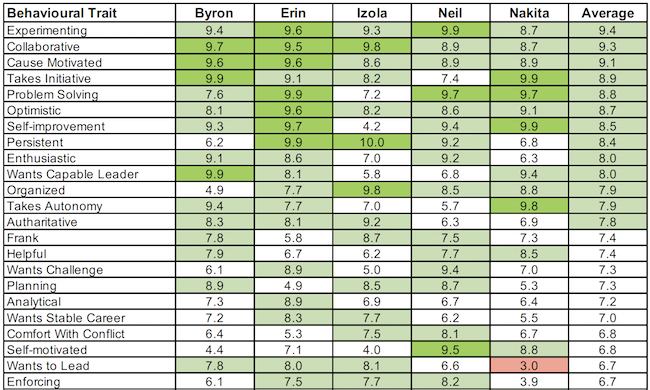Dead Company Values? Top 4 Mistakes Exposed
Do you have a Unique Culture Proposition (UCP)? You’ve probably heard of the term USP, your Unique Selling Proposition – the idea that customers should see something unique in what you offer. But what about culture? What makes your culture unique and does uniqueness really matter?
Most companies have values, but they are “dead values”, not lived and not contributing anything to the culture.
Your company values, when lived, are a powerful component of your culture and are one expression of your UCP. But even having company values is controversial - Brian Roberson, the creator of Holacracy, talks about what he calls the “dark side of values”. His premise is that defining a value (eg: adaptability), implies that you “de-value” its opposite (eg: stability) and that in some situations, that opposite might be more appropriate.
Whilst I have great respect for Brian and the self-management movement (often called Teal), I disagree on this point.
I think, it very much depends on how and why the values were created, and the depth to which they are developed. The problem is that most company values are not well-designed. Here are the 4 biggest mistakes companies make when defining their values;
Mistake #1 - Values that are just 3R values
Most values are created simply to reflect the 3R’s – ie: a “Reasonable, Responsible and Responsive person”. Often, they are expressed as one-word values, like “teamwork” or “communication”. I call these hygiene values that every company will need, in order to succeed in today’s hyper-competitive world. Also, single word values don’t give your mind a “how to” hook. For example, “Be Curious” is a better value than “Creativity” because it’s more specific and tells you what to do.
Mistake #2 - Values that don’t serve your purpose
Most values are not created to serve the company’s purpose. It should be very clear to all your employees, that if they conduct themselves in line with your values, their actions will further your company’s purpose. Of course, this pre-supposes that you have a purpose. The combination of your purpose and values that serve your purpose, become a filter for guiding decisions and working together.
Mistake #3 - Values that don’t reflect “who you really are”
Your values should reflect your unique organisational DNA. The experience your customers have with your brand is strongly influenced by your employees – and their ability to deliver that experience is shaped by your culture. As with a USP, you want your UCP to shine through to your customers so that they see something different to your competitors. We’ve collected a library of over 300 values and whilst there are common themes, the combination of 4 or 5 values that you craft for your company, should be unique to you.
To design a value that genuinely reflects your DNA, using a behavioural analytics tool to can really help. The figure below, is a Harrison Assessment extract for a company’s leadership team:

You can see that this company should have a value centred around innovation because its leaders love experimenting, taking initiative and problem solving.
Having values that come naturally to the majority of your people (ie: that reflect your DNA), is the central key to ensuring they are actually lived and come across as genuine to your customers.
Mistake #4 - Values that aren’t co-created
When we encounter a company with “dead values”, the first question we ask is “how were they created?”. Invariably, one (or sometimes a few) leaders came up with them and then “handed them down to their workforce”. This rarely works. People in your organisation need to be a part of their construction so they can wrestle with what they mean for them in the context of their role and day to day activities.
Co-creating your values gives everyone an opportunity to be part of creating the future and uncovers a core group of employees who are passionate about your culture. These “culture champions” will spearhead behavioural change in your organisation as you seek to live authentically by your values.
An example of a great company value
One of the best expressions of a value I’ve been a part of co-creating is at BrandWorks. They are a design agency in Melbourne with the purpose of “bringing extraordinary to life”. Their value “Anchor ‘N Twist” is deeply authentic to who they are, directly serves their purpose and gives the mind a “how to” hook.
Anchor ‘N Twist is described by BrandWorks’ Co-Founder and Creative Director, Michael Tan this way; “We see through a different lens by asking how we can make the familiar new again. This value played out in our work, when we designed a day-to-night concept for the Goldie Restaurant where we anchored on the popularity of yum cha and dumplings and twisted, by turning it on its head to seamlessly introduce Chinese street food concepts”.
Conclusion
From our research, we know that your employees long to be part of something special. Having a clear purpose and unique supporting values can help create that “something special”. We often hear stories from people who have worked for a company with a clear purpose and strong, lived values. They talk about that culture like a departed loved one. They yearn for the clarity that the purpose gave to help them do “what really matters”. And they hunger for the empowerment the values gave them to make decisions and work together in ways that always advanced that purpose.
Now, back to Brian Robertson’s premise that values have a dark side. What he is really referring to are behavioural traits. And often, seemingly opposite behavioural traits are in fact complementary depending on the degree. This paradox can best be captured in a set of behaviours that operationalise each of your values. To take Brian’s example, let’s say you had a value that spoke to adaptability. I’ll call it; “There’s always another way”. An expression of this value at the behaviours level might be that “we expect to see people flexing our systems when needed, to turn a difficult customer into a fan”. Complementing this behaviour, an expression of the seemingly opposite trait, stability, might be “we don’t want to see systems flexed to the point of breaking down completely”. These complementary behaviours are both ways of operationalising the core value; “There’s always another way”.
So, if you’ve got company values, but they’re not lived and don’t inspire, engage and guide your people, ask yourself; are they just 3R values, do they give the mind a “how to” hook, do they serve your purpose, do they reflect your unique DNA, have they been operationalised with behaviours and were they co-created? Then consider instead, building your Unique Culture Proposition through designing values that will come alive for you. The difference between dead values (which most companies have) and living values is stark. But the positive impact that living values have on alignment, employee engagement and the experience your employees deliver to your customers is worth the effort. Watch these videos to see how leaders and employees from Sutton Tools and Littlepay (a couple of our clients) connect with their living values.
References
Salple takes an integrated, data-informed approach to organisational culture
